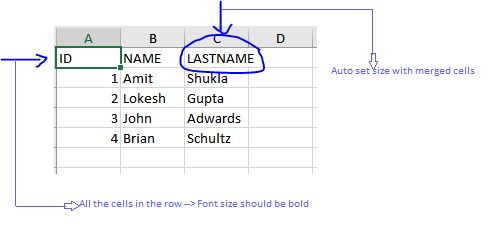


类:
package com.example.TestProject.process;
import java.io.File;
import java.io.FileOutputStream;
import java.util.Map;
import java.util.Set;
import java.util.TreeMap;
import org.apache.poi.ss.usermodel.Cell;
import org.apache.poi.ss.usermodel.Row;
import org.apache.poi.xssf.usermodel.XSSFSheet;
import org.apache.poi.xssf.usermodel.XSSFWorkbook;
public class WriteExcelDemo {
public static void main(
String[] args) {
// Blank workbook
XSSFWorkbook workbook = new XSSFWorkbook();
// Create a blank sheet
XSSFSheet sheet = workbook.createSheet("Employee Data");
// This data needs to be written (Object[])
Map<String, Object[]> data = new TreeMap<String, Object[]>();
data.put("1", new Object[] {"ID", "NAME", "LASTNAME"});
data.put("2", new Object[] {1, "Amit", "Shukla"});
data.put("3", new Object[] {2, "Lokesh", "Gupta"});
data.put("4", new Object[] {3, "John", "Adwards"});
data.put("5", new Object[] {4, "Brian", "Schultz"});
// Iterate over data and write to sheet
Set<String> keyset = data.keySet();
int rownum = 0;
for (String key : keyset) {
Row row = sheet.createRow(rownum++);
Object[] objArr = data.get(key);
int cellnum = 0;
for (Object obj : objArr) {
Cell cell = row.createCell(cellnum++);
if (obj instanceof String)
cell.setCellValue((String) obj);
else if (obj instanceof Integer)
cell.setCellValue((Integer) obj);
}
}
try {
// Write the workbook in file system
FileOutputStream out = new FileOutputStream(new File("howtodoinjava_demo.xlsx"));
workbook.write(out);
out.close();
System.out.println("howtodoinjava_demo.xlsx written successfully on disk.");
} catch (Exception e) {
e.printStackTrace();
}
}
}
对于自动调整列大小,有Sheet. autoSizeLine。您可以在其中指定是否应考虑或忽略合并单元格的内容。默认值是忽略合并的单元格。但是您的问题在这一点上并不明确,因为您的代码根本没有合并单元格。
对于行样式,有Row. setRowStyle。Excel在将新单元格添加到该行时采用该样式。但是apache poi不是这样的。它总是为新创建的单元格使用默认单元格样式。所以我们需要一个方法CellStyle getPreferredCellStyle(Cell cell),它获取给定单元格的首选单元格样式,就像Excel所做的那样。
而且,既然您在询问最佳实践,请尽可能使用org.apache.poi.ss. usermodel.*。因此代码能够处理HSSF和XSSF而无需进行太多更改。
示例:
import java.io.File;
import java.io.FileOutputStream;
import java.util.Map;
import java.util.Set;
import java.util.TreeMap;
import org.apache.poi.ss.usermodel.*;
import org.apache.poi.xssf.usermodel.XSSFWorkbook;
import org.apache.poi.xssf.usermodel.XSSFCell;
import org.apache.poi.hssf.usermodel.HSSFWorkbook;
import org.apache.poi.hssf.usermodel.HSSFCell;
public class WriteExcelDemo {
static CellStyle getPreferredCellStyle(Cell cell) {
// a method to get the preferred cell style for a cell
// this is either the already applied cell style
// or if that not present, then the row style (default cell style for this row)
// or if that not present, then the column style (default cell style for this column)
CellStyle cellStyle = cell.getCellStyle();
// if no explicit cell style applied then cellStyle.getIndex() is 0 for XSSF
// or 15 (0xF = the index to the default ExtendedFormatRecord (0xF)) for HSSF
if ((cell instanceof XSSFCell && cellStyle.getIndex() == 0) || (cell instanceof HSSFCell && cellStyle.getIndex() == 15)) cellStyle = cell.getRow().getRowStyle();
if (cellStyle == null) cellStyle = cell.getSheet().getColumnStyle(cell.getColumnIndex());
if (cellStyle == null) cellStyle = cell.getCellStyle();
return cellStyle;
}
public static void main(String[] args) throws Exception {
// Blank workbook XSSF or HSSF
Workbook workbook = new XSSFWorkbook();
//Workbook workbook = new HSSFWorkbook();
// Create needed cell styles on workbook level
Font boldFont = workbook.createFont();
boldFont.setBold(true);
CellStyle headerRowStyle = workbook.createCellStyle();
headerRowStyle.setFont(boldFont);
// This data needs to be written (Object[])
Map<String, Object[]> data = new TreeMap<String, Object[]>();
data.put("1", new Object[] {"ID", "NAME", "LASTNAME"});
data.put("2", new Object[] {1, "Amit", "Shukla"});
data.put("3", new Object[] {2, "Lokesh", "Gupta"});
data.put("4", new Object[] {3, "John", "Adwards"});
data.put("5", new Object[] {4, "Brian", "Schultz"});
// Create a blank sheet
Sheet sheet = workbook.createSheet("Employee Data");
// Iterate over data and write to sheet
Set<String> keyset = data.keySet();
int rownum = 0;
for (String key : keyset) {
Row row = sheet.createRow(rownum++);
if (rownum == 1) row.setRowStyle(headerRowStyle); // row style for first row; Excel takes that style when new cells are added to this row
Object[] objArr = data.get(key);
int cellnum = 0;
for (Object obj : objArr) {
Cell cell = row.createCell(cellnum++);
cell.setCellStyle(getPreferredCellStyle(cell)); // set the preferred cell style for the new cell as Excel would do
if (obj instanceof String)
cell.setCellValue((String) obj);
else if (obj instanceof Integer)
cell.setCellValue((Integer) obj);
}
}
for (int c = 0; c < data.get("1").length; c++) {
//sheet.autoSizeColumn(c); // autosize, merged cells should be ignored
sheet.autoSizeColumn(c, true); // autosize, merged cells should be considered
}
// Write the workbook in file system
String filepath = (workbook instanceof XSSFWorkbook)?"./howtodoinjava_demo.xlsx":"./howtodoinjava_demo.xls";
FileOutputStream out = new FileOutputStream(new File(filepath));
workbook.write(out);
out.close();
workbook.close();
System.out.println("howtodoinjava_demo.xlsx written successfully on disk.");
}
}